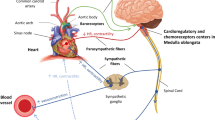Abstract
Objective
The time preceding brain death is associated with complex dysregulation including autonomic dysfunction that may compromise organ perfusion, thus inducing final organ failure. In this study, we assessed autonomic function in patients prior to brain death.
Methods
In 5 patients (2 women, median 60 years, age range 52–75 years) with fatal cerebral hemorrhage or stroke and negative prognosis, we monitored RR-intervals (RRI), systolic and diastolic blood pressure (BP), and oxygen saturation. Adjustment of mechanical ventilation remained constant. We assessed autonomic function from spectral powers of RRI and BP in the mainly sympathetic low- (LF, 0.04–0.15 Hz) and parasympathetic high-frequencies (HF, 0.15–0.5 Hz), and calculated the RRI-LF/HF-ratio as index of sympathovagal balance. Three patients required norepinephrine (0.5–1.6 mg/h) for up to 72 h to maintain organ perfusion. Norepinephrine was reduced to 0.2–0.5 mg/h within 2 h before brain death was diagnosed according to the criteria of the German Medical Association. Wilcoxon test compared average values of ten 2-min epochs determined 2–3 h (measurement 1) and 1 h (measurement 2) before brain death.
Results
We found higher systolic (127.3 ± 15.9 vs. 159.4 ± 44.8 mmHg) and diastolic BP (60.1 ± 15.6 vs. 74.0 ± 15.2 mmHg), RRI-LF/HF-ratio (1.2 ± 1.6 vs. 3.9 ± 4.0), and BP-LF-powers (2.7 ± 4.8 vs. 23.1 ± 28.3 mmHg2) during measurement 2 than during measurement 1 (p < 0.05).
Conclusions
The increase in BPs, in sympathetically mediated BP-LF-powers, and in the RRI-LF/HF-ratio suggests prominent sympathetic activity shortly before brain death. Prefinal sympathetic hyperactivity might cause final organ failure with catecholamine-induced tissue damage which impedes post-mortem organ transplantation.



Similar content being viewed by others
References
Smith M (2004) Physiologic changes during brain stem death—lessons for management of the organ donor. J Heart Lung Transplant 23:S217–S222
Lowensohn RI, Weiss M, Hon EH (1977) Heart-rate variability in brain-damaged adults. Lancet 1:626–628
Baillard C, Vivien B, Mansier P, Mangin L, Jasson S, Riou B, Swynghedauw B (2002) Brain death assessment using instant spectral analysis of heart rate variability. Crit Care Med 30:306–310
Goldstein B, DeKing D, DeLong DJ, Kempski MH, Cox C, Kelly MM, Nichols DD, Woolf PD (1993) Autonomic cardiovascular state after severe brain injury and brain death in children. Crit Care Med 21:228–233
Wissenschaftlicher Beirat der Bundesärztekammer (1997) Richtlinien zur Feststellung des Hirntodes. Dritte Fortschreibung 1997 mit Ergänzungen gemäß Transplantationsgesetz (tpg). Deutsches Ärzteblatt 95:A1861–A1868
Besser R (2001) Empfehlungen der Deutschen Gesellschaft für klinische Neurophysiologie (Deutsche EEG-Gesellschaft) zur Bestimmung des Hirntodes. Klin Neurophysiol 32:39–41
Rudiger H, Klinghammer L, Scheuch K (1999) The trigonometric regressive spectral analysis—a method for mapping of beat-to-beat recorded cardiovascular parameters onto frequency domain in comparison with fourier transformation. Comput Methods Programs Biomed 58:1–15
Task force of the European Society Of Cardiology and the North American Society of Pacing and Electrophysiology (1996) Heart rate variability: standards of measurement, physiological interpretation, and clinical use. Circulation 93:1043–1065
Saul JP, Berger RD, Chen MH, Cohen RJ (1989) Transfer function analysis of autonomic regulation. II. Respiratory sinus arrhythmia. Am J Physiol 256:H153–H161
Ziemssen T, Gasch J, Ruediger H (2008) Influence of ECG sampling frequency on spectral analysis of RR intervals and baroreflex sensitivity using the EUROBAVAR data set. J Clin Monit Comput 22:159–168
Laude D, Elghozi JL, Girard A, Bellard E, Bouhaddi M, Castiglioni P, Cerutti C, Cividjian A, Di Rienzo M, Fortrat JO, Janssen B, Karemaker JM, Lefthériotis G, Parati G, Persson PB, Porta A, Quintin L, Regnard J, Rüdiger H, Stauss HM (2004) Comparison of various techniques used to estimate spontaneous baroreflex sensitivity (the EuroBaVar study). Am J Physiol Regul Integr Comp Physiol 286:R226–R231
Hilz MJ (2002) Quantitative autonomic functional testing in clinical trials. In: Brown R, Bolton C, Aminoff M (eds) Neuromuscular function and disease. W.B. Saunders, Philadelphia, pp 1899–1929
Beloeil H, Mazoit JX, Benhamou D, Duranteau J (2005) Norepinephrine kinetics and dynamics in septic shock and trauma patients. Br J Anaesth 95:782–788
Chen EP, Bittner HB, Kendall SW, Van Trigt P (1996) Hormonal and hemodynamic changes in a validated animal model of brain death. Crit Care Med 24:1352–1359
Shivalkar B, Van Loon J, Wieland W, Tjandra-Maga TB, Borgers M, Plets C, Flameng W (1993) Variable effects of explosive or gradual increase of intracranial pressure on myocardial structure and function. Circulation 87:230–239
Baroldi G, Di Pasquale G, Silver MD, Pinelli G, Lusa AM, Fineschi V (1997) Type and extent of myocardial injury related to brain damage and its significance in heart transplantation: a morphometric study. J Heart Lung Transplant 16:994–1000
Pennefather SH, Bullock RE, Dark JH (1993) The effect of fluid therapy on alveolar arterial oxygen gradient in brain-dead organ donors. Transplantation 56:1418–1422
Novitzky D, Rose AG, Cooper DK (1988) Injury of myocardial conduction tissue and coronary artery smooth muscle following brain death in the baboon. Transplantation 45:964–966
White M, Wiechmann RJ, Roden RL, Hagan MB, Wollmering MM, Port JD, Hammond E, Abraham WT, Wolfel EE, Lindenfeld J et al (1995) Cardiac beta-adrenergic neuroeffector systems in acute myocardial dysfunction related to brain injury. Evidence for catecholamine-mediated myocardial damage. Circulation 92:2183–2189
Cooper DK, Novitzky D, Wicomb WN (1989) The pathophysiological effects of brain death on potential donor organs, with particular reference to the heart. Ann R Coll Surg Engl 71:261–266
Rapenne T, Moreau D, Lenfant F, Boggio V, Cottin Y, Freysz M (2000) Could heart rate variability analysis become an early predictor of imminent brain death? A pilot study. Anesth Analg 91:329–336
Acknowledgments
This study was partially supported by the International Brain Research Foundation, IBRF, Inc., Edison, NJ, USA.
Author information
Authors and Affiliations
Corresponding author
Rights and permissions
About this article
Cite this article
Marthol, H., Intravooth, T., Bardutzky, J. et al. Sympathetic cardiovascular hyperactivity precedes brain death. Clin Auton Res 20, 363–369 (2010). https://doi.org/10.1007/s10286-010-0072-8
Received:
Accepted:
Published:
Issue Date:
DOI: https://doi.org/10.1007/s10286-010-0072-8




